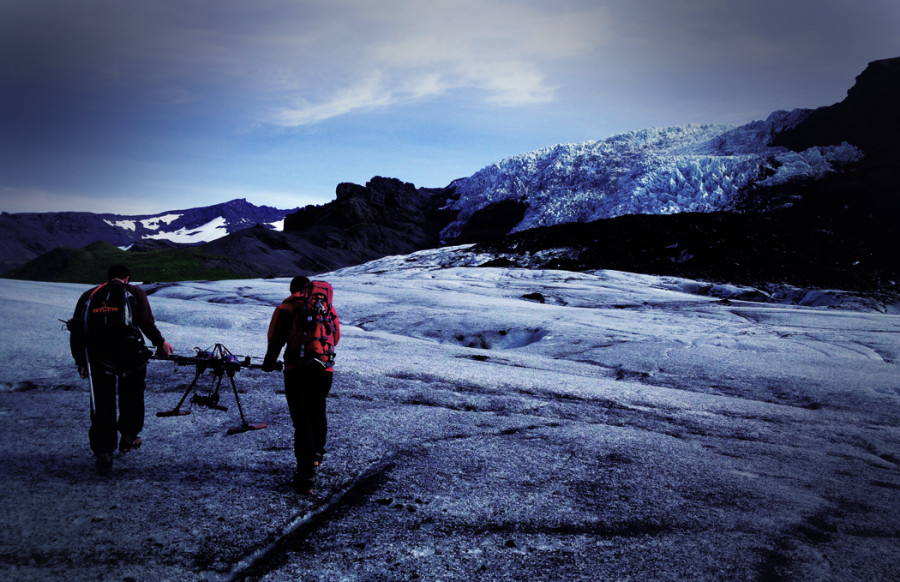The Sky’s the Limit
Skysmith Cinedrones Bring Cinematography to New Heights
No one can deny that modern technology is reaching unimaginable new heights—but when it comes to film, this statement can be taken literally. Drones have now been introduced to the cinematography scene, and Skysmith Cinedrones is flying them down an artistic path.
Tim Zafir, a Concordia graduate who majored in Communication Studies with a focus in film, has been at the forefront of this new cinematic technology, growing out of his love for flexible camera movement.
“Me and some of my mates were always interested in camera movement particularly, so we were building cable cameras and cranes and dollies and little robotic heads and whatnot for filming and getting cooler and cooler shots every time,” he said.
Although it began as just an interest, Zafir’s experimenting, and the ideas that went along with it, brought his work to the forefront of contemporary mobile-operated camera technology.
“In the last two years, the multi-rotor popular name drones have come into the [amateur] filming world and even more recently into the professional filming world,” he said.
“In the past [professionals] have had the budget to shoot with helicopters and whatnot so there hasn’t really been too big a need, but now we’re able to get really close with the shots and get really intimate scenes then pull out really far to show breathtaking landscapes.
“That’s a new technique that never really existed before in cinema.”
With such an exciting new tool, it wasn’t hard to get a team on board. Benjamin Granet—who was working as a stone carver before meeting Zafir—was quickly drawn into the art form.
“Tim was always talking about the drones, the drones, the drones, and I was curious to see what he was talking about,” said Granet.
“One weekend Tim asked if I wanted to go filming and I said yeah, of course. So we went for a small filming and I really enjoyed it, […] I was really interested.”
Cameras Roaming the Skies
Skysmith’s filming drones are remote-controlled flying machines with a mounted camera and a small CPU inside, attached to various types of sensors. A gyroscope keeps the drone balanced and stabilizes the camera, the barometer stabilizes the altitude and a GPS keeps it on course.
Zafir was able to coordinate with Canada’s first drone manufacturer, DronExperts, to solicit the resources to get Skysmith off the ground, so to speak.
“I met a commercial pilot and he was building multi-rotor helicopters more for the purpose of industrial uses and lower-end filming of weddings and things like that,” Zafir said. “I came to him with the need of building bigger, badder machines so we can put bigger, badder cameras on there and get shots that have never been seen before in cinema.”
With DronExperts as a resource, Zafir and Granet have been able to concentrate more on the artistic side of production.
“I like the idea that DroneExperts and Skysmith are brothers in the same family,” Zafir said. “They’re helping us with the technologies and the resources we need to grow as an artistic company.
“But at the end of the day, technology is technology and it’s nothing without the humans behind it,” he continued. “I’m more concerned with creating the teams and pushing the artful uses of this technology instead of focusing on the dollar.”
All New Possibilities
Skysmith sees more potential for drones than just capturing breathtaking cinematography.
Because much of the footage captured by their machines is so rare to attain, it has a lot of power, and to Zafir it offers the opportunity to do a lot of good.
“What really attracts me is any opportunity for us to get into the frontier locations,” said Zafir. “For instance, Ben and I are planning on going down to Patagonia to film a bunch of aerials for the conservation projects fighting the foreign hydroelectric dams that are coming in there and wanting to dam up the Patagonian mountain region between Chile and Argentina.
“It’s one of these last wilderness frontiers that is somewhat untouched by man and there are people down there wanting to protect it,” he explained. “The problem is they don’t have a massive voice because there are so few of them and it’s far away from the rest of the world, so we want to go down there and give them images that will really speak to the hearts of the public.”
But beyond their power for change, drones also aid cinematographers in their own exploration.
“It’s exciting—when I was standing there on this glacier in Iceland last year with a bunch of ice climbers and mountain guides and we were flying across this glacial tongue,” Zafir said.
“For the first time they were seeing images and new routes through this glacier which they could now go through. So we were pioneering, we were basically seeing images and opportunities in these incredibly rugged landscapes that have never been seen before.”
But the company knows full well that untrodden trails will make for hard hiking, both physically and financially.
“It’s new. As far as the industry goes, we’re not just trying to work; we’re also trying to create our job at the same time,” said Zafir. “We’re paving the path while we’re walking on it.”



_600_832_s.png)


__600_375_90_s_c1.jpg)

